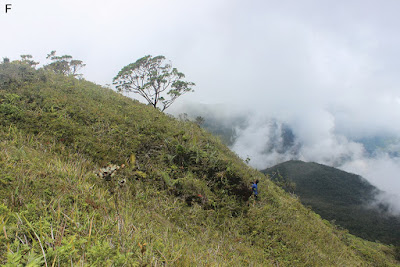 |
| Dilochia deleoniae Tandang & Galindon
in Tandang, Galindon, Tadiosa, Coritico, et al., 2020.
|
Abstract
A new species, Dilochia deleoniae Tandang & Galindon (Orchidaceae), from Mindanao Island, Philippines is described and illustrated herein. This species is distinct from other known Philippine Dilochia species by its terrestrial habit and is distinguished from all known Dilochia species by its monopodial inflorescence, rarely branching in two, and a pale yellow to dull orange or brownish-yellow labellum devoid of purple spots.
Keywords: biodiversity, Mount Hamiguitan Range Wildlife Sanctuary, orchid taxonomy, world heritage site
Dilochia deleoniae Tandang & Galindon, sp. nov.
Diagnosis: This species is distinct from the two known epiphytic Philippine species by having an entirely terrestrial habit. Further, among the characters that separate it from other known Dilochia species, the new species has a monopodial inflorescence or rarely branching in two. It is similar to D. beamanii Ormerod (Ormerod 2015) of Sabah, Malaysia in its reproductive structures. Both species have a terminal flower, with similarity in shape and color of bracts, sepals, and petals. Furthermore, their columns are both winged and with small variation in length. However, the new species has a monopodial inflorescence or rarely branching in two, bearing 7 to 9 flowers (vs. a 3- to 6-branched inflorescence bearing ≥ 13 flowers in D. beamanii); dorsal sepal 11-veined, lateral sepal 10-veined, and petal 8-veined (vs. dorsal sepal 5-veined, lateral sepal 5-veined, and petal 7-veined in D. beamanii). In addition, the labellum of D. beamanii is yellow-ochre with white margins and apex, and with purple spots, whereas the new species has a labellum with a white base and a pale yellow to dull orange or brownish-yellow lip from the disc to the margins and is consistently devoid of purple spots.
 |
| Figure 2. Dilochia deleoniae Tandang & Galindon sp. nov. F habitat on the summit of Mount Hamiguitan, forest over ultramafic soils.
photo by John Michael M. Galindon.
|
Distribution: Endemic to the Philippines. Mindanao Island, Davao Oriental, San Isidro Municipality, Mount Hamiguitan Range Wildlife Sanctuary.
Habitat and ecology: This terrestrial orchid species prefers open to partly shaded habitat, where it is found in clumps or scattered. The populations rarely occur in forest over ultramafic rocks between elevations ca. 1100–1200 meters above sea level (m a.s.l.) but is common in the pygmy forest ecosystem at the mountain summit between 1560 and 1650 m a.s.l. This new species was recorded inside a sampling quadrat, growing with other native orchid species such as Appendicula tembuyukenensis J.J.Wood and Dendrochilum kopfii Lückel., and with other species such as Agathis sp., Dacrydium beccarii Parl., Dacrydium elatum (Roxb.) Wall. ex Hook., Falcatifolium gruezoi de Laub., Gleichenia vulcanica Blume, Leptospermum javanicum Blume, Machaerina disticha (C.B.Clarke) T.Koyama, M. glomerata (Gaudich.) T.Koyama, Medinilla myrtiformis (Naudin) Triana, M. theresae Fernando, Myrsine amorosoana Pipoly, Scaevola micrantha C.Presl, Symplocos polyandra (Blanco) Brand, Tasmannia piperita (Hook.f.) Miers, and Vaccinium spp.
Etymology: The new species is named after Ms Josefina De Leon, the former Chief of the Wildlife Resources Division under the Biodiversity Management Bureau of the Department of Environment and Natural Resources, who has pursued wildlife conservation for more than 35 years and who remains a biodiversity conservation advocate. During her time in the Bureau, the FORIS project was launched and researchers from the National Museum of the Philippines were invited to be part of the technical working group that led to the discovery of the new species.
Danilo N. Tandang, John Michael M. Galindon, Edwin R. Tadiosa, Fulgent P. Coritico, Victor B. Amoroso, Noel E. Lagunday, Rene Alfred Anton Bustamante, Darin S. Penneys and Peter W. Fritsch. 2020. Dilochia deleoniae (Orchidaceae), A New Species from Mindanao, Philippines. PhytoKeys. 139: 91-97. DOI: 10.3897/phytokeys.139.46935

